
a collection of notes on areas of personal interest
- Introduction
- Arabic / Islamic design
- Arabic / Islamic geometry 01
- Arabic / Islamic geometry 02
- Arabic / Islamic geometry 03
- Arabic / Islamic geometry 04
- Islamic architecture
- Islamic urban design 01
- Islamic urban design 02
- Islamic urban design 03
- Islamic urban design 04
- Islamic urban design 05
- Arabic / Islamic gardens
- Gulf architecture 01
- Gulf architecture 02
- Gulf architecture 03
- Gulf architecture 04
- Gulf architecture 05
- Gulf architecture 06
- Gulf architecture 07
- Gulf architecture 08
- Infrastructure development
- The building industry
- Environmental control
- Perception
- The household on its lot
- A new approach – conceptual
- A new approach – principles
- A new approach – details
- Al Salata al jadida
- Public housing
- Expatriate housing study
- Apartment housing
- Pressures for change
- The State’s administration
- Society 01
- Society 02
- Society 03
- Society 04
- Society 05
- Society 06
- History of the peninsula
- Geography
- Planning 01
- Planning 02
- Population
- Traditional boats
- Boat types
- Old Qatar 01
- Old Qatar 02
- Security
- Protection
- Design brief
- Design elements
- Building regulations
- Glossary
- Glossary addendum
- References
- References addendum
- Links to other sites
Housing for expatriates
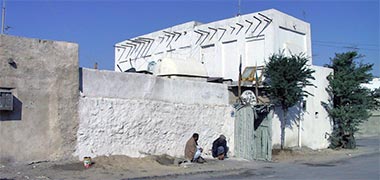
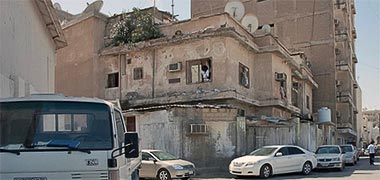
The reason I have called out this character of physical development is that it tends to differ from the residential developments that Qataris make for themselves. These buildings form a significant proportion of the built environment due to the high percentage of expatriates there are living in the country. Because of this preponderance their appearance, for good or ill, has much to do with the character of the urban environment. As you would imagine, styles reflect the type of expatriate for whom the housing is constructed or, as in this first example, converted. The second example also shows a housing unit constructed for the expatriate community, this originally being for the mid-range staff but moving down-market as it deteriorates. Behind it can be seen the larger housing units now being constructed on the more valuable land.

Contrasting with the old houses of Qataris that now mostly house labourers, there are a wide range of styles of housing developed for the private sector. This sector provides housing directly, but mostly indirectly, to government. The wide range of expatriates in the country require housing either as individuals or families. Many companies bring in their own staff and house them in apartment blocks, segregating by sex. Middle and senior management and professionals tend to be housed in apartments or villa-style estates. This photograph shows a street in a private development intended for families or groups of professional bachelors.
With a large proportion of the population consisting of expatriates, there has been – and continues to be – a need to provide housing for them. This housing is mostly established on a relatively large scale on sites located towards or on the periphery of the urban development where land ownership or assembly is in large enough plots. These sites are owned and developed by major businessmen or by groups of businessmen who develop in the knowledge that they have a guaranteed market for the housing they will develop there. Often there are associated facilities with the housing, both to make it more attractive to residents as well as making it a fit development to associate with the developer’s name. The tenants of the housing may be employed by the developer or they may work for another company, but in all cases the probability is that there will have been an arrangement to the mutual benefit of all involved in the introduction and employment of the expatriates.

These developments mostly fall within the pattern adopted by the private sector and are almost invariably developed within boundary walls providing a notional degree of physical and psychological security. At their entrances are arrangements similar to that shown here, consisting of a guard house or houses with either a single or double gate control system operated electrically from within the guard house. Utilising closed circuit television systems supplemented by mobile patrols within and around them, the compounds are generally considered safe to live in though, paradoxically, there is little crime in Qatar. The boundary wall system serves not only to provide a small degree of security while defining the housing, but it isolates these compounds from the other communities living in their immediate neighbourhoods. There is a little more written about the more general areas of this subject on the pages dealing with protection and security as well as the page looking at the societal aspects of security and privacy within the peninsula.
Despite the implications of confirmed occupation, there is considerable competition between Qataris to keep their properties marketable and avoid their sliding down-market with the resulting loss in revenue whether or not the tenants work for them. It is a difficult area to operate within but one which enables the government to distribute a part of its earnings from gas and oil, so enabling Qataris to profit and move funds into the local economy, and elsewhere, of course.
At its crudest there can be thought to be three levels of expatriates brought into the country to carry out the professional, managerial and labour tasks not taken up by Qataris. The housing provided for them has little to do with the traditional architecture of the peninsula though, if any of it does, it seems to be the housing for workers, usually multi-storey development compared with the majority of two and three storey villa and row housing developments provided for managerial and professional expatriates.
To some extent this might be thought to reflect the origins of the expatriates coming into the country, but is more likely to be a reflection of the designers and their remit, multi-storey buildings usually requiring a less expensive design solution than row housing or villas and their associated land uses and landscaping.

This is an example of housing which is characteristic of the type provided for expatriate professional and managerial staff. It might be found in almost any country, there being little to suggest the part of the world in which it is located, though the accacia trees might be a hint. Housing such as this is usually developed within walled and secured compounds and represents safety and a degree of familiarity to the Westerners living there. This is not a top of the range development as the road servicing the houses has little landscaping associated with it, and the housing is heavily exposed to the road, the urban character being relatively hard and likely to be hot and characterless compared with other housing in Qatar developed with more consideration of the internal environment.
This type of housing is typical of its sort and similar, in terms of its concept, to this example on the preceding page. By and large, these compounds make no contribution to the development of a national architecture, relying as they do on international style in planning concept, design and detail. It can be argued that expatriates benefit from living in familiar surroundings but in a country which is relatively safe, there is no real need. More likely the argument is that there is benefit both to nationals and expatriates for the latter to live in discrete housing developments and not mix with nationals.
Whatever the argument is, not only does this architecture make no contribution to a national style, but it is poor of its sort. You can see from the above illustration that not only is there little planting to ameliorate the harsh environmental conditions, but the housing is mirrored on both sides of the street and can not, therefore, be planned and detailed from an environmentally concerned design vocabulary.

Here is another scheme, similar in many respects but, possibly, worse in certain of its aspects. The urban design is composed only of hard elements though I imagine there will be sensible but relatively small areas of planting associated with the private areas of the houses. At the front of the properties, where there is an opportunity to benefit both the resident and the community, there is little or nothing to soften the hard architectural vocabulary. The unnecessary steel fence at the front of the properties could have been replaced by planting with benefit to the street as well as to the residents. Certainly no landscaping alleviates the front of the properties shown. Hard surfaces retain heat and this factor, together with the small amount of planting within the overall housing area, will contribute to the compound having a relatively poor micro-climate to the disbenefit of those living there.

The buildings themselves pay lip service to Islamic architecture with the addition of poorly proportioned and detailed pointed arches, cornices, crenellation and a small amount of applied pattern and colour. But these are applied and not integrated elements of the architecture. Perversely, the opportunity has been lost to provide protection from solar gain to the windows. The ground and first floor windows of the building on the left are a prime indication of the lack of consideration: if the first floor projection is designed to protect the ground floor window, what protects the first floor window?
The pavements are not designed for pedestrian movement as can be seen by the location of street lamps on them, and I note that there is one broken on the right, indicating that they are not of substantial construction. And there is no considered provision for refuse carts as can be seen by one sitting by the open garages on the right.
I should expand on my comment relating to the pedestrian path for those unfamiliar with the environment of the peninsula. It makes considerable sense to have walls provide shade to pedestrian routes during the summer. If this was the prime consideration for this pedestrian path – that the wall is on the south or west side of the road – then the lighting posts are in the wrong place or of the wrong type. If the path wouldn’t provide shelter during the hot months of the year then it would have been better to provide planting instead. My guess is that it would have been a financial decision to produce this maintenance-friendly solution, but there is an opportunity missed. Landscaped housing appeals to tenants and its costs in terms of application and maintenance could be reclaimed through the rental system.
It may seem a little unfair to be critical of projects such as this as there are worse schemes elsewhere in the world, but I feel that it’s worth making the point again: every poorly designed scheme is an opportunity lost to move a regional or national design style forward. Not only that, every poorly designed scheme disbenefits its users by not providing elements that would make life more attractive or bearable. That is what designers are supposed to do; they should not restrict themselves to adding decoration without consideration.
New styles of architecture are evolving all the time with the twin attempts to create housing attractive enough to rent easily and to provide development which will reflect well on the country, an objective with which we in the West are not really familiar but which is sought in a wide variety of fields.
Regrettably, the speed of modern development does not always produce the best results, and many housing projects have been constructed which could have benefited from more consideration and better design.
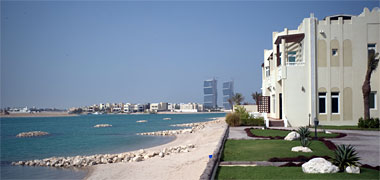
Here is a development of housing in the New District of Doha, designed to take advantage of its littoral setting. These houses are five-bedroomed semi-detached, and one of their unique selling points is their location with a small private terrace immediately in front of them giving onto a lower terrace, and then a small beach leading directly to the water. I don’t know how many other features have been carefully considered but the houses can hardly be said to take full advantage of their location.
It is also unclear the extent to which tenants will be able to customise their relationship with each other and the water in terms of jetties, anchorages, beach furniture, access and so on. There may also be legal issues as well as practical difficulties to overcome with time such as encroachment, possible silting and noisy activities related to the water or terraces.

Bearing in mind that this is semi-detached housing and that the houses have five bedrooms, it is evident that only two main rooms – one on each floor – take advantage of facing the sea, the view you would anticipate being the main focus for the houses. The flimsy, short timber screen between the houses at ground floor level gives little privacy and is virtually redundant. Oddly, most terraced or semi-detached housing for expatriates pays far more attention to privacy and security for commercial reasons associated with rentability than does this housing. I suspect there will have to be more consideration given to this aspect, even though the timber screens suggest otherwise.
With regard to detailing there are a number of features to note. Firstly, an attempt has been made to produce a hint of traditional architecture with the rounded device at first floor balcony level as well as the hint of a badgheer at roof level. Neither are well considered, the former looking extremely uncomfortable in its detailing and junctions with the windows. From a practical point of view this detail will produce streaking down the wall when it rains.
In addition to that, the windows have neither solar protection on the outside – the houses face south-west, the heaviest solar loading – nor is there any provision to protect window heads from rain. At first floor level the windows adjacent to the joint party wall are opening lights which means that air-borne sound transfer is likely to be a problem and that fire spread is a real possibility.
There is also the argument that semi-detached housing, whose designs are reflected, can not be equally responsive to external environmental conditions. One side is likely to be better off than the other – in this case the house on the right receiving the morning solar loading and that on the left, the afternoon loading, the main façade of both houses receiving the sun from mid-morning, onwards.
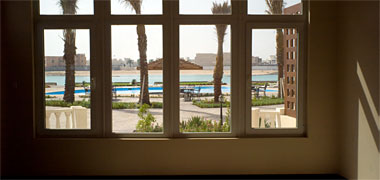
Finally, there are two more issues to note. The first is a personal and particular irritation in that the main windows are divided into four panels, introducing duality to the interiors. I have written elsewhere about the psychological problems this creates, but it is aggravated here by the very heavy mullions dividing the windows and destroying what should be a major feature of the interior – the view of the water. I don’t really understand why the horizontal mullion is where it is, or why it is there at all as the top lights are fixed. At least it doesn’t get in the way of the view though it does have the psychological function of lowering the view out of the windows.
The other point to note is the relatively low level of the window which, while allowing daylight to penetrate further into the room, makes any arrangement of furniture near the windows, problematic due to sunlight penetration. This introduces a general design consideration. Where windows receive the sun, there is generally a disinclination to use this part of the room in summer, cutting down the usable space in the room. In addition, furniture suffers under continual solar exposure, even when specialist glass is used.

Many properties rented to expatriates do not have the money spent on them to provide for the lifestyles of those who will live in them. Insufficient privacy is a common problem. Owners are forced to produce their own solutions in order to be able to use their houses as they would like. In this photograph the roofs of this group of houses have normal parapets to provide for safety, but the owner of the house nearest the road has felt the need to erect a cane screen to provide additional privacy for those of the household using the roof. Though there is the added advantage to the use of cane screens in that they allow a degree of air movement through them, this is not really a good design solution.
More to be written…
Senior Staff housing for Umm Said
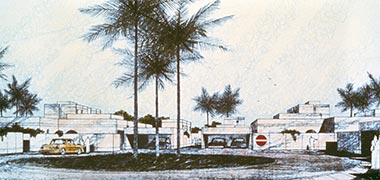
A variety of housing projects, as well as a number of tentative designs, can be found on other pages. Here, however, is a project by The Architects Collaborative for the provision of housing for Senior Staff at Umm Said that might be compared with those shown above. I am not sure if any of this was actually built, but here are some of the images that were produced for the project. Unfortunately there seem to be no plans of the houses, but much can be assumed from some of the photographs of the models. Bear in mind that the grades of Senior Staff would have encompassed both European and Arab expatriates.

In order to create a useful mix of residential units, the housing was designed as both single and double story units. Note that the single story house illustrated here has windows in its flank walls. As can be seen from the perspective lower down the page, it was obviously intended that the houses would not have secured boundary walls but would be open to pedestrian or vehicular access on all sides. From the client’s point of view this would have been wasteful of land, less flexible and potentially less secure.

In the centre of the house there is an elevated atrium, apparently enclosed though clerestory lit, with the kitchen at the far side linking on its left with the living spaces and, on its right, with the bedrooms. There is likely to have been a bathroom adjacent to it as guests would need to be able to wash their hands – both European and Arab – and this would certainly not have suited practice for the latter as it would take them into the family side of the house. It is possible that there is a guest wash room associated with the entrance but if this is the case there is no natural ventilation for it, and it would be difficult to access from the dining area.

The double storey housing is shown as a pair of semi-detached units, again having windows on their flank walls. It is likely that the client would have required either a boundary wall similar to that required by the single storey units above. Although the porosity of the housing layout might be argued to be improved, the sikkak would have been more expensive to produce and have a significant maintenance cost.
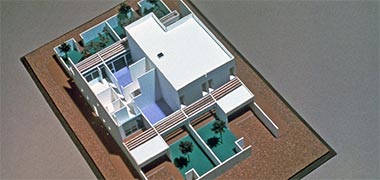
The layout of the double-storey houses appears to be more problematic than the single-storey housing. Access to each house is from a sikka with the difficulties that introduces for maintenance. Bear in mind that Umm Said is relatively open to dust and sand movement, being close to the sand dunes to its south that are the start of the Empty Quarter.
Access to the living room or majlis is straightforward, but if the dining room is to be used, then guests must cross into the family side of the house, suggesting that the intention would be to have food served in the majlis for Arab households. A small roof light is shown above the staircase, and there is no access to the roof which is strange as there will be at least water tanks located there. This brings up the design issue that although there is a small upstand at the periphery of the roof, there is insufficient visual screening provided for any units placed on the roof.

Generally the architectural style is sympathetic to the traditional architecture of the peninsula with solid walls containing small, round-headed windows similar to TAC’s work elsewhere in the Gulf. Where there are large windows to living areas, they appear to be well protected from solar gain by overhanging structures and with visual security provided by high boundary walls. Bedrooms generally have tall, narrow windows in the corner of rooms, an effective way of reflecting light deep into rooms.
Retail outlets

There are many photographs of the old suq on this site and elsewhere, but this photograph gives an indication of the character of the old retail outlets in the centre of Doha, this view looking north at the top of suq waqf, the photograph taken in January 1974. The basic needs of households were relatively simple and catered for within different areas of the suq each devoted to a specific type of goods. In the part of the suq shown here there were tinned goods, tools, spices and the like. Out of picture, right, was the vegetable and meat suq and, spreading east, pots and pans and a variety of downmarket items.
The suq was accessible on foot from the housing immediately to the south by a number of sikkak, but the expansion of population saw the need for larger and more modern retail spaces satisfied by the development of shopping on the roads radiating from the old centre.
The road within wadi Musheirib – and becoming the Salwa Road leading to Saudi Arabia – was the main feed out of the suq and, as development moved south and west, retail outlets were developed along it and on roads branching north such as shara’ Abdullah bin Thani and shara’ al-kahraba’, as well as along the Rayyan Road leading due west from the Diwan al-Amiri and Sheikhs’ masjid. Several members of the royal family also developed residential complexes along the Rayyan Road.

These two photographs illustrate something of the different characters of this early expansion of retail activities. The first photograph shows the type of shops with apartments or stores over them situated at the Arab Bank roundabout. Ali bin Abdullah Street enters the roundabout on the left, and al-Asmakh Street on the right. The image also illustrates the beginnings of the state’s intent to develop a townscape vocabulary by the introduction of landscaping with the use of planting and, in this particular case, water, the Arab Bank fountain becoming a popular feature.
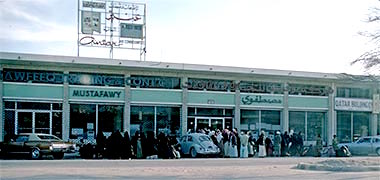
This photograph shows a larger character of retail space further west along the road from the Arab bank. It, and similar showrooms, were able to take advantage of lower land prices in order to develop stores particularly capable of displaying larger items such as white goods and building equipment. These outlets were developed with a tall frontage and an internal mezzanine, so doubling part of the footprint and providing for storage and administrative functions at the rear of the space.
Darwish Cold Stores
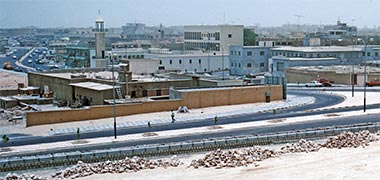
This may seem to be an unusual addition to even a brief selection of old buildings in Doha or even Qatar, but the Darwish Cold Stores, seen here from the Diwan al-Amiri and situated immediately to the east of its entrance, was an important building, particularly for Western expatriates. It, together with the Ali bin Ali Cold Stores situated at the north end of Abdullah bin Thani Street, was where imported foods, sourced in Europe, could be readily found. Contained in a single storey building, seen here with Darwish’s small masjid to its east, it had kerbside parking and a heavily cooled interior. The Ali bin Ali Cold Stores had similar parking and occupied the ground floor of a two storey building.
Round the corner from the Ali bin Ali Cold Stores was a street leading west and confusingly also known as Abdullah bin Thani Street, but known to Westerners as ‘Breadshop Street’ where, as the name implies, there were a number of bread shops along with Mukherji’s, a third popular food store for Westerners. The bread shops were situated on the north side of the road with, from memory, a number of mainly material stores on the south side. Breadshop Street led west to Electricity Street where the most important store was the Darwish’s ‘Modern Home’.
The Darwish family were one of the more important, if not the most important, trading group in the peninsula. Their original operations centred on the seaside at the head of the wadi leading to the West Bay and the sea. In order to facilitate moving produce from the ships standing out at sea, merchants had properties on the littoral between the suq and what became the Diwan al-Amiri on the high ground, half a kilometre to the west. In addition to their land at the north end of the suq, the Darwish family developed the land just in front of the Diwan al-Amiri with their cold stores and masjid on the north side of Abdullah bin Jassim Street, with stores, a travel agency and other uses on its south side, as well as south of the Sheikhs’ masjid where Abdullah Darwish had his house.
Ali bin Ali Stores

One of the other grocery stores that was popular with Western expatriates was the Ali bin Ali stores situated near the north end of Abdullah bin Thani street. The retail outlet was housed on the ground floor of the two storey building shown here with, I believe, a bank on the ground floor of the four-storey structure to the right. Immediately to the north of this was the residence of Sheikh Suheim bin Hamad al-Thani, which occupied a site bounded by Abdullah bin Thani Street, Rayyan Road, and Electricity Street. The building in the left foreground is the corner of the Central Fire Station.
Darwish Modern Home
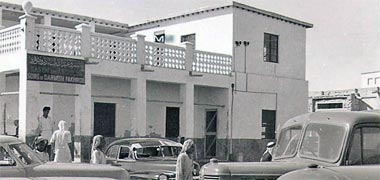
The business established by Darwish bin Jassim Fakhroo was expanded under Abdullah al-Darwish and his brothers Jassim and Abdulrahman. This saw the family moving from their trading store which had been operating since the 1920s in the suq – to a site with a much larger footprint in the early 1950s on the west side of Electricity Street. There is a little more written about it on one of the pages looking at the old buildings in Qatar.

Electricity Street, or shara’ al-kahraba’ was named for the state’s first diesel-powered electricity generating station that was constructed near its south end. The street contained a number of two and three storey buildings with apartments sitting above retail spaces, the most important of which was the Darwish’s new ‘Modern Home’.

The new showrooms were designed to display and sell something of the Western way of life not just to nationals but also to the increasing numbers of expatriates coming into the country. Its first major agency was obtained for Rolex watches in 1951, the name being prominently displayed on the façade of its expanded showrooms, shown in the lower photograph. For the first time in the country the showrooms were developed over two floors in order to contain the wide range of consumer products for which Darwish was by then the agent. These included Sony, Chanel, Bally, Piaget, Christofle and, I think, Kenwood. Other major merchants, such as al-Mana, Ali bin Ali and al-Mannai had similar agencies, it being a requirement that foreign companies doing business in Qatar should have an agent.
There are other images on one of the two pages looking at some of the older buildings in Qatar.
Malls

Until the 1970s, most of the public’s shopping requirements were taken care of at a series of local centres around the peninsula, together with a small number of supermarkets, gradually increasing in size to accommodate, particularly, an expanding expatriate population. Nevertheless the friendly, local shop has continued to thrive, catering for the immediate needs of the local communities, this one photographed by night where it is also a focus for informal meetings and the exchange of information. However, times change, and even though this end of the retail hierarchy continues to meet local needs, there are a series of shopping units increasing in their size at the other end of the hierarchy, and which cater not just for retail needs, but also passive recreation.
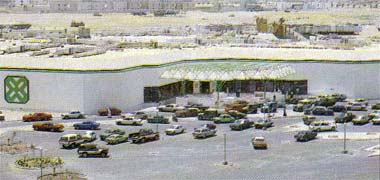
The first large shopping centre to be opened in the peninsula, known as The Centre – and signed in Arabic, markaz – was located in the north-east sector of the intersection of the Salwa Road and ‘C’ Ring Road, and this was closely followed by others. Completed in 1978, the Centre was considerably larger than any of the single retail centres then in existence and brought a significant air of modernity to Doha. While not a mall, the Centre acted as an intermediate transition from the more traditional shopping areas to the malls yet to proliferate. It would not be long before it was overtaken by the introduction of larger stores established by nationals and their agents believing this was one way to harvest more of the disposable incomes being paid to the expatriate community.
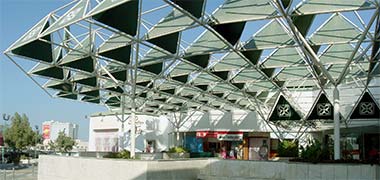
Architecturally designed as a simple cruciform in plan with splayed corners both on plan and on its roofline, it displayed only a small area of windows on its external façade, these being used for display adjacent to the entrance. The building was covered internally by a green-painted Mero space frame roof to create a column-free retail area. Externally the same space frame, incorporating a canvas infilling, was used to create the shaded entrance canopy, further illustrating the modern character of the store. The geometry of the roof structure, based on a square grid, reflected something of the plan of the building which was developed graphically as a logo to advertise the store.
The same roof and shade system was used on a number of other projects in the peninsula, notably the National Development Exhibition building, and the zoo at Shahaniyah.
On an earlier page I wrote about the manner in which the shopping experience has been developed into a theatrical experience. Large sums of money have been spent on producing architectural settings in which nationals and expatriates can experience a setting similar to what the might see on television, or they might experience abroad. It is set design. It dislocates those in it from the reality of their lives in Qatar in an attempt to free them of the money in their pockets. Of course, this is not a novel experience. All over the world retail outlets are being produced which attempt to do the same thing. In Qatar the attempt is to obtain the financial return from a relatively small proportion of the population as many of the expatriates do not earn enough to fund the lifestyle promised by such developments nor, by extension, give the return to the developer.

Much of the time these developments are relatively empty, their design seeming to reinforce this feeling through its long perspectives and hard surfaces. This first photograph shows a mall where minimal lip service has been paid to Qatar with the use of a semi-circle geometry and decorated panels, though strangely including a debased classical column and capital motif, and on one side of the mall only.
At weekends and evenings these malls fill up as people take their equivalent of the Italian passeggiata, the evening stroll which has more of a social function than a commercial one, though the malls do cater for the need for people to relax over a coffee or snack. Malls are places to experience and in which to be seen but, more than that, they are places to see yourself in a special environment, one which is, usually, significantly upmarket from the home or work environment. This has brought with it a social issue where security has been introduced in order to prevent an actual or perceived threat from social interactions.

But to take the Italian metaphor a little further, Qatar now has a mall of pure Venetian pastiche. It is not the only one in the world outside Venice, but it certainly demonstrates the manner in which theatre has been brought to the shopping experience and, as I have pointed out elsewhere, it has been developed at the expense of the traditional suq which itself, in Doha’s suq waqf, has been redesigned as a heritage opportunity.
The Diwan al-Amiri


The offices of the Diwan al-Amiri were expanded in the nineteen eighties and, combined with the old structure to its east, are a very imposing and important element of the overall Corniche urban design. These first two photographs, both taken from the north of the development, show the relationship between the old and new elements of the Diwan. The aerial photograph shows the old Diwan with its central courtyard to the left and the new, symmetrical Diwan on the right, within a heavily landscaped setting, and with the Corniche passing at the foot of the photo. The lower photograph – taken from the artificial island created in the centre of the bay – especially illustrates the different characters and scale, while additionally showing the visual intrusion of two of the larger buildings constructed some distance south of the Diwan. The manara of the Sheikh’s Mosque can be seen on the left of the photograph.

To show something of the setting and character of the old Diwan Al-Amiri, this first photograph, one I took in the late nineteen seventies, is an aerial shot from the north-east. It shows what was then considered to be the important State grouping – the Diwan al-Amiri to the right, the Sheikh’s mosque, top left, and the Clock Tower, left centre. The building at the extreme left of the photograph and that in front of the clock tower and next to the small mosque, belonged to one of the important merchant families, the Darwish, who owned this part of Doha. The Foreign Ministry was developed on this lower site which, at the time the photograph was taken had been cleared and was being used as a football pitch.
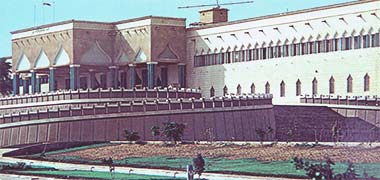


This group of photographs illustrate something of the character of the façade of the old Diwan al-Amiri. This is the external façade, with its continuous row of ogee-headed arches, that faces due east towards Doha’s central suq and has an extremely strong presence, as would have had the older buildings developed on this prominent site. The main entrance to the northern courtyard is on the left of the photograph and the ramps and steps said to have been modelled on a Scottish half-moon battery, in the foreground. These steps never had a real function other than dealing with the ground levels as there was no access allowed down to the small garden on the right to which they led, nor were either of the ramps ever used for vehicular access. The second photograph was taken around sixteen years after the first and shows not only that the planting had developed, but that a shade device had been provided leading to the main entrance, albeit of too small a scale. In the last photograph, taken by night, the presence of the Diwan is even stronger due to the combination of its mass and the highly repetitive decorative arches.
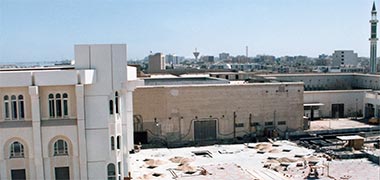
The new Diwan al-Amiri project was constructed directly to the west of the original building. The old building had a large gate directly opposite its main, east, entrance leading to the original structures associated with the first development there. To the south of this gateway in the old building was a kitchen and, to the north, the State dining room, though this was not often used, certainly not as much as the majlis on the north of the building. This photograph shows the gateway looking south of east from the roof of the new Diwan al-Amiri project. On the right of the photograph can be seen the southern courtyard of the old Diwan al-Amiri building.
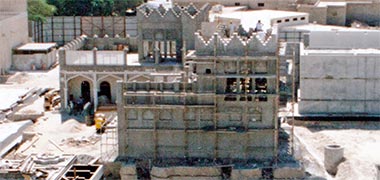

There were a number of older buildings to the west of the old Diwan al-Amiri that were retained within the overall planning of the new Diwan al-Amiri project. Two of these were old buildings designed and constructed in the traditional Qatari architectural style. This first building was located just inside the boundary wall on the southern edge of the Diwan complex. The decision was taken to reconstruct the small group with the intent that it might be used on occasion to entertain guests, particularly those from outside the country. A team of government craftsmen carried out the work of rebuilding and decorating with naqsh plasterwork. The building can be seen in the photograph below, and was just within the inner southern entrance gate. The second photograph shows another of these old buildings, also near to and within the inner southern boundary wall and to its east, in this case with its restoration work completed.
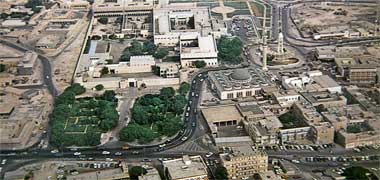
This aerial view of the south end of the Diwan al-Amiri, taken in 1972, gives a good idea of the original arrangement of the complex. The older parts of the development lie to the left, the Diwan al-Amiri with its two courtyards, on the right. The Grand Mosque and Clock Tower are clearly seen, as is the east end of the Rayyan Road viewed feeding in bottom left. The south garden of the Diwan al-Amiri was always well maintained, but not used, again for security reasons. The area to the left, west, of the old Diwan al-Amiri is that on which the new Diwan al-Amiri was constructed.

Here is the Diwan al Amiri from the old jetty to its north-east, the relatively bland façade of the left side of the building being a part of the old Diwan al-Amiri to which the heavily articulated, new design behind it and to the right was attached. Sitting on a slight rise in the ground it appears as a very strong element of the urban design of the Corniche due to both its size, form and height as well as its relatively isolation from other buildings on the Corniche – the government buildings to its east, and the commercial development of the New District of Doha some distance to its north and west.


These two photographs show the Diwan al-Amiri over the bay from the New District of Doha to its north-west with the old Diwan al-Amiri to the left of the new building. Behind the old Diwan al-Amiri the minaret of the Sheikh’s Mosque can be seen. As is evident, the Diwan al-Amiri has been designed with a very different architectural vocabulary from the modern architecture of Qatar. The design for this large building was based on a real attempt to develop a modern architecture based on traditional Qatari architecture, and considerable thought went into this objective. Generally, it is more successful than much of the more modern architectural designs which have followed it and which are often pastiche and incoherent borrowings with little relevance to either Qatar or the region. I should add that the plan form of the Diwan al-Amiri is U-shaped, the courtyard being on the south side of the building. The main elements of massing were the Ruler’s offices in the centre with two wings each side.
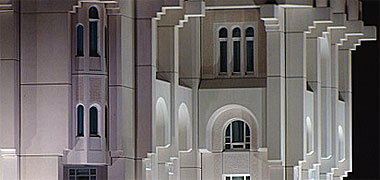
These next two photographs were taken at night and show the Diwan al-Amiri under artificial lighting. The first photo has been taken obliquely across the front of the north wing, facing the Corniche. You can see that the style of the building may be characterised as of a trabeated form, and that the elements which go to form both the trabeation as well as the infill panels are pre-cast and very large. This is not pastiche but is an honest attempt to recreate the form of Qatari buildings, introducing modern methods of construction to deal with the much greater scale of the new architecture.
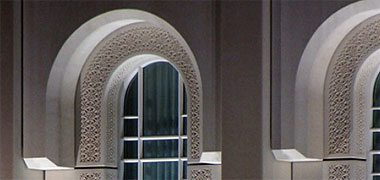
This detail of one of the windows illustrates two important aspects of the architecture: firstly the use of heavy articulation to give form to the building as well as assisting in the reduction of solar gain through its windows; and, secondly, the use of traditional naqsh carving to enliven elements of the pre-cast panels. In this case, the naqsh was carved by a team of Qatari craftsmen, a mould taken from their carvings and used to line the pre-cast concrete formwork.



Viewed here from the Corniche to its north-west, and under construction in October 1983, the new Diwan al-Amiri – sometimes referred to as the Doha Palace – was contracted out as a number of design-build packages in order to obtain both the character and quality of work envisaged by the client. Each of the packages were based on client initiated design briefs which were seen to be a necessary method of directing the design of a building whose external presence would represent the face of Qatar both to those living in the country as well as to foreign dignitaries visiting the country. Its interior, in particular, would need to reflect this. Both the manner in which it presented itself through its urban positioning, as well as the detailing of its interior at the different scales to which it was to be experienced, were seen to be crucial in creating this integrated development. The various design-build packages were issued to a small number of carefully pre-qualified contractors, this method allowing the design intent of the client to be coordinated and assured while complying with the government’s legal requirements established and monitored by the government’s Central Tenders Committee. The central of the three photographs above shows an element of the pre-cast concrete external cladding being manoeuvred into position in December 1983, while the lower photograph is a detail of a glass sample reflecting the relatively simple design intent derived from the detailing of traditional architecture of the peninsula.

Work continued on the Diwan al-Amiri for a number of years using, as mentioned above, design-build packages in order to enable each to focus on the specific design element of the project. Although the construction elements of the project were carried out rapidly, finishing to the high standards required took some time with the external works and some of the small scale packages being the last to be completed. Occupation was not fully effected until the beginning of the 1990s.
Much of that work is described on another page of these notes, though a brief note on the external landscaping continues on this page.

Thirty-five years later, this image was developed from a photograph made from a United States aircraft taking part in a flyover on the occasion of Qatar National Day, 18th November 2019. The image shows something of the development which now exists between the Rayyan Road and the Corniche, essentially of al-Bida where there is now a landscaped park.
There are many different disciplines involved in the design of buildings of this importance and character. One of them, as might be expected, being security which impacted not only the structure and façades of the Diwan, but also the external development of the building with particular respect to its curtilage, boundaries and landscaping.
It is not possible to describe details here, but the design of landscaping associated with the Diwan was considered not only for the areas around the building and on its periphery, but also within its walls and out of sight of the general public. There the landscaping had to complement the new building as well as develop in harmony with the traditional buildings on southern edge of the development.

Access to the Diwan was designed to be from either the west side, which would be a new entrance or, as it was to the original and retained Diwan building, from the east. This arrangement continues with guests driving through the older Diwan through its courtyard and into the courtyard to the south of the new Diwan. In this image, a Head of State approaches with the reorganisation of the landscaping around the Clock Tower apparent on the right.


However, the main face of the Diwan was considered to be that overlooking West Bay. The first two of the following three sketch illustrations shows, from ground level within the northern boundaries of the site, one of the approaches considered for the external works, that of incorporating water which, it was envisaged, would conceptually link the building with the sea of the West Bay immediately to its north, over its boundary wall and the Corniche. The second illustration, an aerial view of the model, demonstrates how the water features would be grouped to align with the central façade with, flanking on both sides, date palms and other shorter trees and planting which would accentuate the importance of the building by framing its central features while permitting the main mass of the building to be seen above and through the foliage.
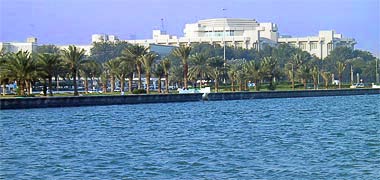
This photograph, which was made in January 2002, was taken looking over the south edge of the West Bay from the old Port jetty looking south-west. It shows the Diwan al-Amiri appearing over the Ministry of Foreign Affairs and the trees of the Corniche, contrasting the long horizontal roofline of the Diwan with the more amorphous form and colour of the trees.

This third sketch is important in that it shows how consideration was to be given to the existing traditional buildings that were to remain, and be refurbished, to the south of the main Diwan development. Here it was envisaged that the floor paving would be developed, stepped in places, and more common local trees, perhaps the ubiquitous ficus, would be used to contrast with the traditional buildings, distinguishing them from the palms with their more regular geometry used adjacent to the new Diwan.
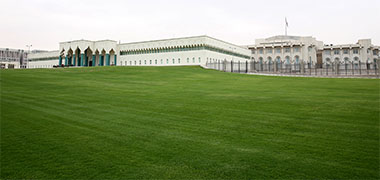
With the continuing development of this area of Doha, the road system has been amended and the old and new buildings of the Diwan al-Amiri are now to be seen from further away as is shown in the lower image, the old Diwan al-Amiri in front and to the left of the new development, the area between the buildings and the nearby road linking the Corniche with the central development of Doha grassed and without any buildings or planting that would mask them. This might be considered to be a combined security and urban design solution.

This image shows something of the drama created with the lit Diwan al-Amiri by night viewed over the water of the bay. The new development is on the right or west of the old Diwan al-Amiri, and the clock tower can be seen on the left of the photograph with the manara of the masjid al-shyuwkh rising behind it. The white dot in the sky above the new Diwan al-Amiri is the white edge close to the flagpole of a large Qatar flag.

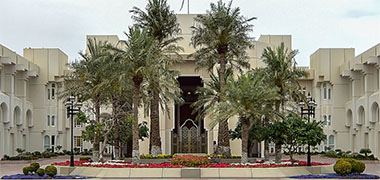
The Diwan al-Amiri complex is an imposing development both from the outside on its prominent rising ground, as well as from inside as is illustrated in this government image of the main entrance courtyard of the new Diwan al-Amiri. The east and west wings of the building stretch south to contain the main entrance, with the flank wall of the old Diwan al-Amiri glimpsed to the right of the photograph.
This lower photograph, a detail of the image above shows, behind the central planting feature, the bronze screen masking the actual entrance to the Diwan al-Amiri and illustrates something of the scale of the imposing entrance. This is one of the settings used for the meeting of visiting dignitaries and inspections of a guard of honour.


The Diwan al-Amiri was completed and occupied some time ago, and is seen here in this first aerial photograph taken in 2011. The photograph shows the relationship of the Diwan al-Amiri complex with the Corniche crossing the picture top right – the Ruler’s jetty being just out of picture. The Clock Tower roundabout is in the bottom right of the photograph with the old Diwan al-Amiri building between the Clock Tower and the new Diwan al-Amiri building.
The old building was having work carried out on it in this photograph but that work is now, in 2023, complete and the courtyard landscaped. The old parking area north-east of its entrance has disappeared. The photograph shows the Diwan in its relationship with the Corniche, the distancing giving it both a degree of security as well as a comfortable space to view it in urban design terms. The photograph also illustrates clearly the disposition of the three wings of the building; the two office wings on the east and west of the central atrium, the third wing on the north side taking advantage of the views directly over the West Bay.
As was anticipated, there have been continuing changes to the Diwan al-Amiri over time, and it is evident that it has become an important setting for visiting dignitaries with both its outer and inner landscaping being refined and developed over time. This plan animation shows the area in February 2003, August 2013 and February 2023 respectively.

The Diwan al-Amiri development is impressive and imposing in its position on the Corniche. Now seen some degree removed from its closer association with the central old suq due to the removal of intervening buildings, reorganisation of roads and the installation of low landscaping, its position on the high ground gives it a significance enhanced by the retention of the old Diwan al-Amiri to its east. This aerial image of it, looking approximately north-west over the masjid al-shyuwkh, shows how the whole of the development, old and new, now appears.

The old Diwan al-Amiri catered for both staff and vehicle parking by having them park immediately outside on the east side of the building and north of its formal entrance. With little space available within the internal courtyard, essentially this area was reserved for security purposes. The only cars allowed inside the Diwan being those of members of the Royal family, ministers, visiting dignitaries and ambassadors. Service vehicles were permitted to come into the courtyard when absolutely necessary, but generally they entered from the south gate.

In order to cater for the large numbers of staff now using the old and new Diwan, cars have been provided with the ability to park in a three-level underground structure outside the south side of the Diwan below what used to be a garden area adjacent to the Rayyan Road. The above aerial photograph is taken from the south, entrance to the structure is on the east side, opposite the masjid al-shyuwkh. There is additional parking at grade in the area south of the masjid al-shyuwkh.
The images above can be compared with the aerial view of the gardens on another page containing historic views of the State.

As was mentioned above the development of the Diwan al-Amiri was carried out to high levels of finish, with teams of craftsmen constructing elements of the building both in Qatar as well as in their many different countries, then placing and finishing their work on site. A team of local craftsmen carved the naqsh panels in situ, a feature of the building linking the past with the present. This image, taken at the reception to honour a visiting Head of State, illustrates something of the central atrium with the grand staircase on the left, west side of the atrium.
While the above photograph does not show the contrasting colours and textures of the decorative timber ceiling structure covering the space, it illustrates something of the quality of the design and finishing of the building, with elements of the traditional architecture of the peninsula married to modern materials and detailing. Inlaid into the central marble flooring, for instance, is a design developed from traditional carved naqsh panels, an element of the design vocabulary which is carried throughout the building on its walls, floors and ceilings.

Finally, as a record of the project, here is a photograph of a block of Qatari fifty dirham stamps with a first day cover dated the 22nd February 1987, marking the fifteenth date of the accession of the then Ruler, Sheikh Khalifa bin Hamad al-Thani, and illustrating the Diwan al-Amiri.
The image also shows the autographs of the late Bruno Fiorentino who was responsible for the interior design elements of the Diwan, and the late George Batori of Rader, Mileto and Batori, who was responsible for drawing together the architectural design requirements from the wide group of individuals involved in the design of this important project. Although not mentioned here the artist, the late William Mitchell should also be recorded for his contributions to the development of the design of the Diwan al-Amiri, all under the aegis of the Technical Office of the Office of H.H. The Amir.
There is more written on the development, particularly of its interior, on another page.
more to be written…
Roads and their relationship with the past
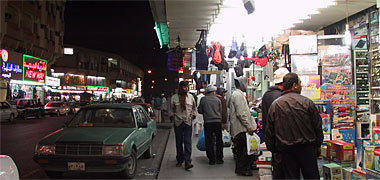
With the development of oil in the late 1940s, wealth began to trickle into the economy. One of the first significant signs of this was the number of vehicles that began to appear in Qatar, mostly belonging to the oil industry and those dealing with them. With this increasing wealth, ownership and use of vehicles expanded vehicle use and the roads had to be developed in order to accommodate them.

In the centre of the suq pedestrians still predominated along with a small number of animals used for porterage. A few vehicles were introduced, in the main belonging to the merchants whose business were still located in the old centre of Doha. These were both personal cars, very much a status symbol, along with the beginnings of vehicular goods transport. The old pattern of streets were not usable by vehicles and so remained as they were, the new or expanded roads being mainly on the periphery of the centre with the exception of the Wadi Sail, shown top right at night, and below it in the daytime – a little closer to the sea – which was used as a main access into the suq and, through it, the old port and sea to the north. As it was a wadi, there were occasional floods even after the construction of a dam to the west designed to protect the centre.


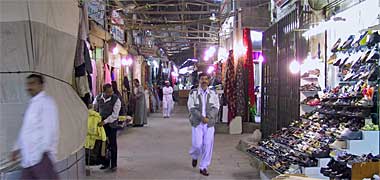
This first photograph illustrates one of the entrances to the old covered suq, and is just to the left of the photograph illustrated above. This part of the covered suq ran more or less parallel with the main street and contained on it, and branching off it, the gold suq, and areas for a number of specialities such as clothing, spices, hardware, household goods and tailors with an interesting part which seemed to be reserved for badu and their interests.
The other two photographs were taken in the covered suq and show the widest part of the internal system. Although these photographs were taken relatively recently, the goods look the same to me and seem not to have changed in years. I recall how this part of the suq allowed water to run down it in the winter rains. The only real differences between this and what it looked like thirty or so years ago is that the ground has now been paved, there are far less people using it, and I have noticed that none of them is a national. Although most of the shops have been run by expatriates, many of them were run by their Qatari owners and had them sitting there each day, receiving their friends and using the shop as an unofficial majlis and inviting people in to sit and drink tea with them, regardless of their having an interest in buying anything.

The suq is in the process of being reinterpreted or, by the time you will read this, will have been recreated. As you can see from this photograph, it is being reconstructed – March 2006 – in what is thought to be its original style. Both the materials, architectural and structural details are different, however, some giving rise to difficulties that will be discussed on one of the Gulf architecture pages.
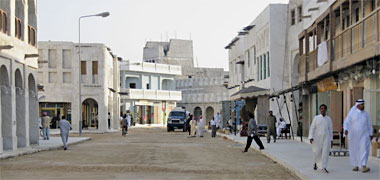
The old Bismillah restaurant can be seen, painted pale blue, at the end of the street – a view of the original can be seen on one of the old Qatar photos pages – but the rest of what you can see here is new and unlike what it supersedes. While this style of development can be considered to respond to a perceived touristic demand, it will be interesting to see how this works commercially in the context of all the other retail developments existing and under construction in Doha.
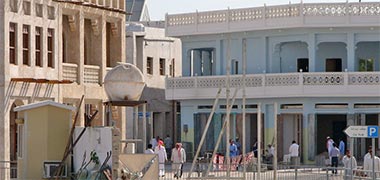
Photographed in the early 2000s, here is a view across the road of the Bismillah hotel as this part of the suq was being reconstructed in some semblance of its old form. On the left side of the building was a passageway that contained a small traditional café and tailors’ shops along with one that produced cotton dowaashek, a process creating significant dust in the atmosphere. The building can be seen here in, more or less, its original form.
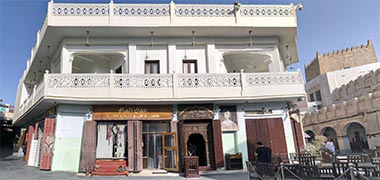

The Bismillah restaurant and hotel has taken on many minor adjustments over the last two generations. Compare these two images – made in 2016 – with those of the original building on one of the pages looking at old photographs of Qatar.
Much of the character of the old Bismillah has been respected in terms of its footprint and elevations, but the modern signage is out of keeping with the building, particularly that hiding the first floor balustrading, and the building seems not to be as welcoming as it once was. In urban design terms this is an important building as it sits on the bend of the road passing through the suq and, as such is a natural and important focus when viewed south or north-east along the road.
As for the design of the two buildings on the right of the lower photograph, and their suitability for incorporation into the traditional style that characterises suq Waqf…

The relationship between sikkak and roads enjoyed a certain ambiguity in the middle of the suq where increasing road usage vied with the traditional pedestrian systems. In the area around it, the new developments of the fifties and sixties established a more modern approach in the design and purpose of roads, but retained some of the character of the sikkak in the spaces between properties. Unfortunately these spaces did not have the residences having access to them that characterised traditional sikkak and were essentially residual spaces, having little use other than conduits for utilities and, perhaps, access for fire fighting. Their character was and, for those that remain, are ambiguous in ownership resulting in a lack of interest in keeping them clean or even tidy. This photograph illustrates how rubbish, rubble and a raised manhole combine with projecting air-conditioning units to bar access for fire-fighting vehicles and produce a squalid environment for those living adjacent to it, or needing access through it. A little more has been written about sikkak on one of the Gulf architecture pages.
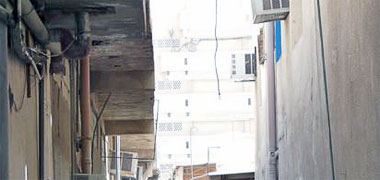
While this photograph of the same sikkak as that above would probably be more sensibly located on the page dealing with utilities, I have included it to illustrate further the lack of concern by the governing authorities of the time for the condition of the sikka. In a sense this reflects the changing nature of the traditional circulation system, and a lack of understanding of how the new spaces should be detailed. The drainage system on the left is noteworthy as it follows a traditional design pattern. The first floor of a building would house the bathroom, the drainage being located outside the building and running down the face of the building. The mixture of pipework and cabling, together with the different materials used reflect a lack of standardisation and changing practices, all contributing to the air of neglect within the public domain.
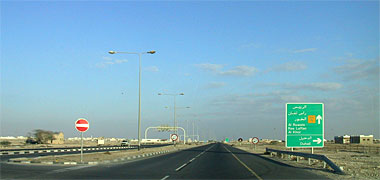
The late nineteen-sixties and seventies saw the introduction of the first roads that might be described as modern. Driven through existing developments near the centre of town, dual carriageways led west from Doha via Rayyan to Dukhan and Umm Bab – the centre of the oil industry, south via Wakrah to Umm Said – the port from which oil was shipped, north via Umm Salal Muhammad and Khor to Al Ruweis, and south-west to the border with Saudi Arabia.
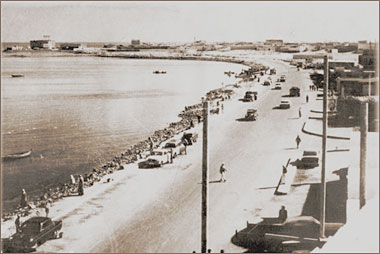
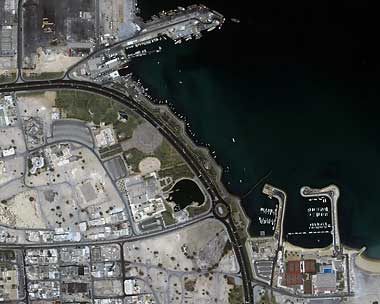
Regrettably I have not yet been able to find suitable photos to illustrate the early roads in the country. However, this photograph taken of the corniche between the Ministry of Education and the old port in the late 1950s, and looking east, gives an indication of a main road of that time and the quantity and character of transport in those days. it can be compared with the photo of the Corniche opposite the Museum at Al Salata below the map of the aerial photograph. The other main road was that leading from the main mosque to al Rayyan, the town in which many of the Royal family were located. In the early nineteen seventies, it was the only road with electric lighting on it, at first from the mosque to the Toyland roundabout – its junction with the ‘B’ ring road ’ but then extended west.
This second, aerial photograph shows the Corniche a little further east at Al Salata, the pattern of the littoral treatment clearly illustrated, and with Doha National Museum and its associated lagoon on the west side of the Corniche. Again, in the early nineteen seventies this was a newly created road having been constructed by piling up stones and, regrettably, some bio-degradable matter, to form the curve seen here. The land to its west was slowly filled with the intent that it would be developed into a park at a later date.



Established in the 1970s, the Corniche was developed to resolve a number of issues. The most important of these was the very low water level of much of the main Doha bay. The opportunity was taken to dredge the bay and, with the dredged material, create new landfill – the New District of Doha – and forming a clean, geometrical edge to the new bay which would enable the sea to scour through it, maintaining a cleanliness that was then absent.
The Corniche included a broad pedestrian system incorporating seating adjacent to the water and a landscaped buffer which included structured car parking. The seating and walkway along the Corniche is very popular for a number of marine-related events ranging from the passive watching of informal and formal events staged in the bay, the sale of small quantities of fish in Ramadthan and recreational fishing.
It is a very popular magnet in the evenings when the Gulf equivalent of the Mediterranean passeggiatatakes place with people of all ages ambling along it while those with the more serious intent on exercising move through them.
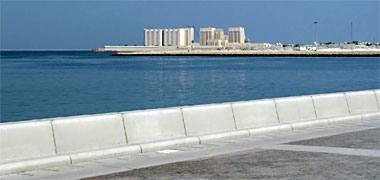
Here you see the original design for the Corniche sea wall. There were three design requirements made of the designers; that:
- the wall should be in scale with its setting,
- the units could be used to sit on, both facing inwards and outwards, towards the sea, and
- that the horizon should not be obstructed.
This latter principle was advised from the beginning but a trial fencing of 50mm tubing was erected adjacent to the dhow port as a decision was being considered. As had been anticipated it was immediately seen to suffer from:
- scale – it did not have the scale required of marine installations, looking weak and flimsy,
- there was concern for maintenance of the metal railing and, most importantly at the time,
- the top railing lined up with the horizon, completely cutting off the psychological link between those driving along the Corniche and the sea.



Over time the road system continued to be developed and roads widened in order to accommodate the increasing traffic but, by the turn of the millennium there was much greater pressure on them than had been envisaged by the relevant ministries and their foreign advisors. This saw the reinforcement of the road system in terms of its widths and traffic controls, and changes from a British- to an American-based system established due, in part, to the training and graduation of young Qataris in the United States and their employment in, particularly, the ministries of Municipal Affairs, and Public Works.
The first two of these three photographs show a standard junction in the New District of Doha, above, and of the ‘B’ ring road and Wakrah road in the existing town, below it. The second photo illustrates, among other things, the amount of traffic the roads now take. The third photo illustrates the normal road system in the New District of Doha where there was more space to design and construct a road system reflecting the more recently developed traffic estimates. In the event, higher density development and greater vehicle ownership and use have created problems even on this part of Doha’s overall road system.
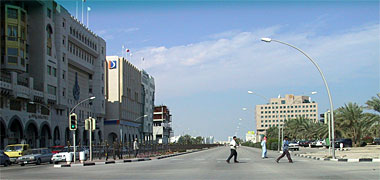
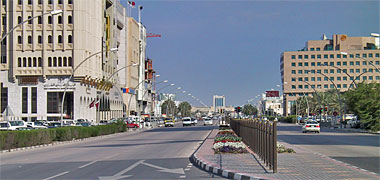

The next four photos were taken in 2003 along Grand Hamad Avenue, looking to the north where it terminates on the Corniche next to the old port having run from its southern junction with the ‘B’ ring road. As you can see from the photographs, there are a number of lots yet to be developed and it is likely that status will continue for some time. The development of Qatar is now physically spread out over a wide area for those projects looking for prestige sites such as this and, of course, there are also prestigious sites within the New District of Doha.
The developments slowly taking place along Grand Hamad tend to be concentrated on the left, west, side though, as you can see, some development is beginning to take place on the east. Although there is a small amount of parking – mainly associated with access – adjacent to Grand Hamad, the master planners have established the main parking for the buildings behind them and at grade. This may well prove to be insufficient in the longer term and it is likely that this policy will have to be reconsidered.

I took the first three photographs when there was little traffic on the road but, as can be seen in this photograph, there can be considerable traffic on the roads, particularly around the suq, making it a significant obstacle to cross at grade at some times of the day. Remember that in the summer people like to go as directly as possible, and the provision of pedestrian crossings, sensibly located by road engineers, can be seen to be an irritation by those needing to cross.
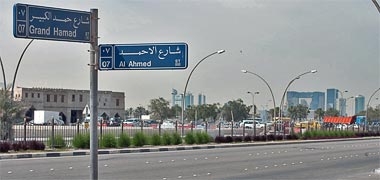
One of the consequences of the spread of building around Doha – and particularly the emphasis of development in the New District of Doha – has been that Grand Hamad is not fully developed despite the length of time it has been cleared for development. More projects are being put in hand in other areas that will continue this trend. It seems a pity that this major urban structure has yet to obtain any of the grandeur that the planners initially intended for it, and that its name implies. This photograph, taken looking north-east from Grand Hamad’s junction with the Al Ahmad Road leading suq al Nasr, illustrates something of the the character that remains towards the northern quarter of this part of the centre of Doha, adjacent to suq waqf.
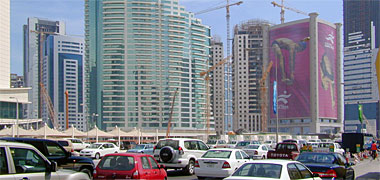
But it is not just the old suq where there is a growing traffic problem as I suggested above. Here, in the Financial District of the New District of Doha, traffic is grid-locked. This has become a source of increasing irritation to drivers and, it is said, one of the reasons behind bad driving behaviour. It is disappointing as the New District of Doha was originally designed to carry the amounts of development planned. I have a feeling that the development there is greater than was planned, but I don’t know the extent to which this might be so, or the extent to which higher vehicle ownership has made its impact.

If this seems to be critical of the road loading problem in the New District of Doha above, it has to be said that traffic is a problem all over the city, and elsewhere for that matter. There is considerable commentary and criticism in the local press but the problem exists not just in Qatar but in other cities of the Gulf as well. The problem exists because of the massive amount of development taking place and the simple fact that traffic planners tend to work on notional models of relatively stable systems, whereas development traffic has a very different character and loading pattern. With time, hopefully, the traffic will settle down as development itself eases off – if and when it does, of course…

The scale of development of the urban landscape relies as much on roads as it does on the scale of buildings. The main roads are now generally dual-threes, and the first underpass at the junction of the Ras Abu Aboud road and the ‘C’ ring road has been supplemented by more to deal with the perceived, if not actual, traffic problems. The scale of this may match that of the housing behind it but you can see one of the concomitant scale problems of car-focussed systems with the hesitant cyclist in the foreground.

As mentioned above there is now, in 2013, a serious problem with the amount of traffic being loaded onto the roads, particularly in Doha. There are now around 880,000 cars on the road system. While this reflects the heavier densities of urban development, it is also a reflection of the timing of activities and the unusual amount of construction traffic responding to the massive physical development in the peninsula. It may be that this photograph is not the norm as it was taken when the summer holiday had finished and schools reopened for the new academic year, but a number of actions have been taken by the Ministry of the Interior in trying to deal with the issue.
The Government is developing a public transport system and the Ministry is attempting to persuade people to stagger their journeys to and from work as well as allowing more time to make their journeys. There have also been recommendations to locate strong attractors outside Doha as well as constructing multi-storey parking structures. But it is not always easy for companies to relocate or alter their work hours, nor for schools, so the recommendation is likely to have only a limited effect on the problem. Multi-storey parking, while providing locations for cars to park, do not alter the amount of traffic on the roads and can also increase it. In the short term, an increase in police patrols is having a positive effect on traffic flows, albeit requiring increased resources.
There is also a recommendation to withhold driving licences from around two hundred categories of expatriate workers. While this relates to a policy adapted in Kuwait, it is thought that it is unlikely to have a dramatic effect on road usage due to the restricted categories relating to no more than 5% of the expatriate population’s licence applicants.
It is evident the transportation system designed in the nineteen-seventies has been developed beyond its capabilities, and it has to be hoped that the policies being promoted will make life easier for those moving around the system.
Public art
A characteristic feature of the road system now is public art in the form of sculptures. In fact, most of the Gulf states have taken it to their several hearts and are establishing sculptures on main roads, usually on, or associated with, roundabouts.

The first ones appeared to be mainly symbolic and followed a tradition that has been going on for thirty or forty years in Qatar. To mark important occasions arches were erected over main roads. Calligraphic enhancements would be added to mark the event and drivers would sustain punctures from the fallen nails used to construct the timber constructions. The arches shown above are more recent, but are similar in form and scale to those of the last century being based on traditional building structures and their detailing.


The first permanent State sculpture was erected at the south end of Grand Hamad Avenue and is based on a pair of crossed swords. The symbolism of a sword or swords is a common one in the Arab world and is seen to relate to the notions of justice, chivalry and bravery of the desert Arabs. It is a potent visual image, its real origin having root in the Holy Quran where it relates to the strength and vigilance of the original Jihad. As such it is a feature not just of calligraphy and design, but of socio-cultural events where it is displayed, particularly in the razeef dance.
The scale of this sculpture is massive in order to keep scale with Grand Hamad. But I feel that its junction with the ground is poor and that it could even have been visually stronger in order to reinforce the beginning of the Avenue. However, it is possible that I have underestimated its symbolic importance which would, to an Arab viewer, make it appear to be a stronger feature than it is to me.

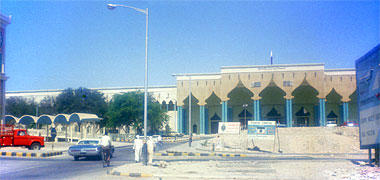
Going back to the nineteen-seventies, here are two photographs, taken in 1970, of the most important group of buildings there were in Qatar at that time. The top photograph shows the manara and domes of the Grand Mosque on the left, the Clock Tower with its surrounding shade feature centre right, and the south wing of the Diwan al Amiri showing above the trees on the right. The lower photograph shows the Clock Tower’s shade feature to the left and the main entrance to the Diwan al Amiri centre right. My understanding is that the Diwan al Amiri was originally built as an office and residential complex for Sheikh Ahmad bin Ali Al Thani, but not used as such. Its imposing position was created by its location on a significant rise to the west of the centre of Doha. This, together with the sheer bulk of the Diwan al Amiri and its ogee arches created the most dominating construction in Qatar at that time.

This photograph is of the original sculptural symbol of Doha, the Clock Tower which stands on the roundabout outside the Diwan al-Amiri. I believe it was constructed around the mid nineteen-fifties. It was a very important element in the urban design of this part of Doha. This, together with the Diwan al Amiri and Grand Mosque were the constructions that appeared most frequently on the State’s publications such as the posters, postcards and books produced by the Ministry of Information in the nineteen sixties and, particularly, the nineteen seventies. There is a photo of it under construction on the Old Qatar page. I don’t have a good image of it on plan, but you should be able to see on the plan photograph below the surrounding arched arcade which, on plan, represents the moon and the clock a star having rays stretching from it as three-dimensionally, diagonally modelled raised paving.
The combination of the moon and star is a symbol found all over the Arab and Islamic world, the star actually being not a star but the planet, Venus which, once a year at the beginning of the holy month of ramadhan, comes extremely close to the nascent moon when it is obvious how the symbolism arose. Bear in mind that the badu, like the ancient Egyptians and others, were very much aware of the heavens due to the lack of light pollution at night in the desert and, therefore, the natural importance of celestial observation.
I had considered the architecture of the clock tower to be related more to the Indian sub-continent than the traditional architecture of the region, perhaps a reflection of the influence of the British engineers under whose influence it would have been designed and constructed. But I have now learned that it was designed by the British engineer Hugh Hale, and was apparently based on a door in the adjacent Sheikhs’ mosque, though this structure was demolished and rebuilt before the Clock Tower was completed. Of course the door might well have been related to influences outside the Arabian peninsula, but I am unable to compare them.
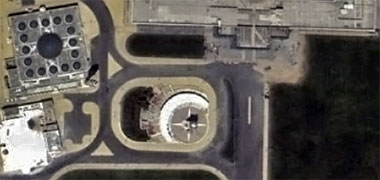
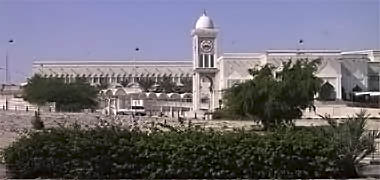
Originally the clock tower was the centre of a roundabout immediately outside the Diwan al Amiri. As such it was a part of the main road system linking Doha with Rayyan, the home of the Royal Family and, in consequence saw a relatively large amount of traffic. The Diwan al Amiri, Clock Tower and Grand Mosque consequently formed the most important urban design feature of Doha and were seen by a lot of people, at least once a week with visits to the Grand Mosque. As such it symbolised Doha, if not Qatar in those days. Here it seems relatively open but you should bear in mind that there was commercial development related to one of the important merchant families on the other side of the clock tower from the Diwan al Amiri.


Here, in the first photograph, you see one of Doha’s Corniche sculptures illustrating an oyster and its pearl, a reminder of one of the chief sources of revenue prior to the discovery and development of oil and gas, and one that was very much associated with the Gulf until the market was undercut by the introduction of cultured Japanese pearls. Below it is another version, this time a double oyster sculpture, and situated at Ruwais in the north of the country. The first sculpture is located with pedestrian access. Elevated from the ground and using the oyster’s lip to form the cascade for water, it is relatively successful as an object. The lower sculpture is less successful in being planted on the floor where it is not displayed as well as that above it. The careful placing and positioning of sculptures is very important if they are to be seen at their best.

Here is a group of three perfume sprinklers, another common theme in the area together with the coffee pots and incense burners that are very much a part of the traditional culture and found in every home. As sculptures they have good height and are clearly visible though I would have liked to see more difference in their relative heights. Situated on the Corniche, I would also have a preference for marine-oriented objects rather than domestic ones.


The next group is of water jars, another common feature of the country, perhaps going back further in time than the previous features and used to keep water at home and at sea. Water is a common feature of Islamic gardens and houses, the best examples, perhaps, being associated with areas of countries where there is little humidity. The reason for this, of course, is that fountains and the like introduce humidity into dry air. Humid countries don’t need them. Qatar is not as humid as, say, Bahrein or Dubai, and at least these sculptures are near the sea where the air is more humid anyway.
Seen here by day and by night it is obvious that the night-time view of the sculpture is preferable where lighting is used to bring out the objects against the dark of night and, by day, the sculpture is – while still recognisable – more jumbled and organised in such a way as to be better seen from one side.

I mentioned previously that coffee pots are a popular subject in the Gulf. These della are an unfortunate grouping. Generally sculpture is intended to be viewed in the round showing itself to advantage to all approaches. Here the della and accompanying cups are lined up, the stand on which they sit may or may not be based on a traditional dikka, there is very little modulation in height and the cups don’t really look like cups. It is a sculpture that, with a little more thought, could be significantly improved.
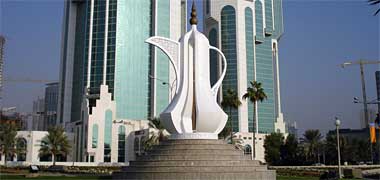
And this might be one way of improving it. Here is a more modern treatment of the literal view of a della demonstrated in the photograph above. The use of a stylised form of della, enlivened by traditional carving on the spout and an exposed vertical section has produced a more interesting version of a della, one more suited to display in this manner. While the profile of the della is not literally correct, and whether you like it or not, it is still an interesting addition to the Doha urban design scene.
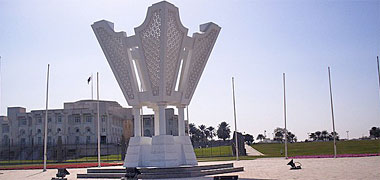
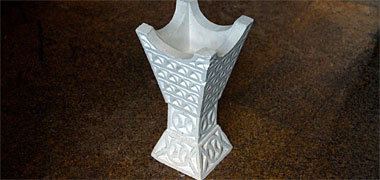
In a very similar style, here is a sculpture, in front of the Diwan al-Amiri, which takes a traditional artefact – in this case, a midkhan, or incense burner – and develops it into a sculptural form. Below it is a photograph of a carved plaster midkhan for comparison, though I should add that incense burners were traditionally made of wood covered in metal to protect from the hot charcoal they were designed to take. Looking at the styles of this sculpture and that above it, they appear to be by the same person, the objects both having been drawn apart by four vertical divisions and being of similar size and material. Both are recognisably of traditional artefacts and are relatively simple in concept and execution. The original artefacts were made of brass in the case of the della, and tin, brass and, often, mirrors, in the case of the midkhan. I assume that they were fabricated in white in order to move them away from being perceived as straight copies of the original artefacts.
Public sculptures are often notoriously difficult to conceptualise. What seems like a good idea at concept stage can lose its way in development and execution. Often they end up being too complicated. When placed on roundabouts they are a significant aid to way-finding as I have mentioned elsewhere, but the very fact they are located on a traffic roundabout means that they do not – or should not – have to be considered in great detail in order to maintain a reasonable degree of road safety.

This public sculpture is interesting in that it displays figurative design rather than the conceptualised forms many of the public sculptures in Qatar demonstrate. A sculpture of a pair of Oryx leucoryx, the beautiful desert animal which now only exists in captivity within the peninsula, sit on top of a heavily designed pedestal. The concept or symbolism of placing a sculpture of these lovely animals on a pedestal rather than at ground level where they live is debatable, but it might be argued that the last place Oryx should be displayed is within an urban environment; and having the most intricate part of a sculpture, the Oryx, farthest away from the viewer seems to be a questionable decision. But it will help in way-finding.


Conceptualising forms is taken further here than in many of the other public sculptures around Qatar. I have not been able to read the lettering on the bottom of this sculpture so I don’t know what its purpose is. But its origins are obvious. The flag of Qatar forms a pair of stylised wings of a bird, two vertical columns supporting the sculpture through its tail, and a stylised olive branch trails nearby. The decision to omit the head of what I imagine is supposed to represent a dove is curious as is the form of the tail which is similar in material and decoration to the supporting columns when it might be thought it should be different. As I wrote earlier, sculptures are often difficult to take from concept to execution without losing something of the original idea.
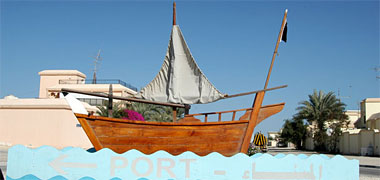
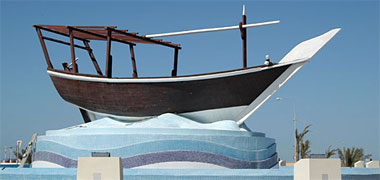
Regional craft are very popular local images, particularly when associated with a sea-side location. Here a rather simplified, and smaller, model of a boom acts as a sign to the port though, by its scale, I think it should also be considered to be a public sculpture, though this might be considered a secondary objective. Perhaps the most apposite items to use as sculptural objects on the Corniche are these local craft and, perhaps, associated artefacts.
Contrasting with it in terms of design and finish, here a shuw’i is set on a stylised sea. Newly painted and lacquered or oiled it is a fitting reminder of a part of Qatar’s heritage and eminently suited to a place by the sea. However, I have an ambivalent attitude towards this particular sculpture because it is a real craft and, beautiful as it may be, it does look, literally, a little out of its element.
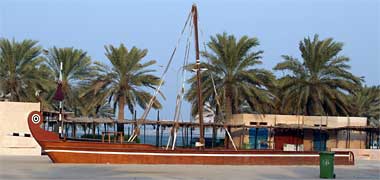
As I mentioned above, boats – both actually and stylistically – are very popular in Qatar. Here, in a public park, there is a notional bateel constructed for the enjoyment of visitors. It is really only the prow that suggests the type of craft intended, but as the bateel has probably the most distinctive of prows that’s understandable. But I do feel that the lines of local craft are so beautiful that it would have been a nice idea to attempt at least some curvature. This is both a sculpture as well as a play or recreation object.
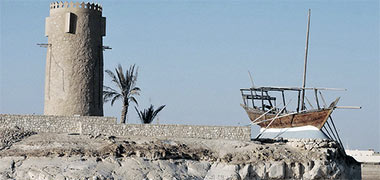
Here, at al-Dhakhira the marine theme has been married with a watchtower illustrating something of the history of the settlement and its history. The dhow is a shuw’i and appears to be a real one that has been re-purposed as an element of public art – though I am not sure that positioning it in the air is the optimal way of displaying it unless its props are real oars. The addition of the notional watchtower and their joint location on a prominent rock outcrop is an interesting and accurate reflection of al-Dhakhira’s history, though one that could be replicated in many of the urban settlements around the coast that depended on fishing, and were at risk from piracy.

The park at al Bida, situated between the Corniche and ‘A’ ring road, contains a number of interesting features, a more recent one being this abstract sculptural grouping.
Sculptures have a number of functions, as I have written about below. At this scale they are important in the character they give to the urban spaces in which they are located as well as creating urban markers – elements which enable people to locate themselves or even wayfind. In a wider sense they give character to the city in which they are located and, by extension, to the culture within which they are created. Some sculptures are designed to perform a function such as protecting people from danger, providing cooling or shading and so on, but many exist without context or function. This, for instance, creates a very strong focal point and, with the addition of the central feature, implies a function, in this case shade and privacy. Or perhaps it acts as a gazebo, a point from which to observe features, usually relating to landscaping.
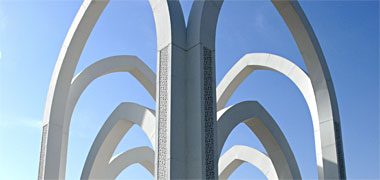
The drama of this particular sculpture lies in its arching form. The pointed arches are found in the traditional architecture of Qatar and the carving that lined the concrete moulds accurately resembles traditional Qatari naqsh, all in all a successful commemoration of traditional architectural themes.

But the central feature seems odd in relation to the arches. Not only does this element seem unnecessarily contrived, but the fretted naqsh carving above the doors and the relationship of doors to over-panel look uncomfortable to me. Despite this I rather like the grouping, but wonder both how it was foreseen it would be used, and how it will be used by the public.

Here you can see a photograph of the sculpture in its setting. It is formally organised to face the roundabout, and lighting is provided to illuminate it at night. There is no provision for visitors within it nor is there any activity associated with it. As I have mentioned above, the naqsh carving is interesting at close inspection, but the construction appears to be solely designed as an object. Perhaps it could have been a little more than this.
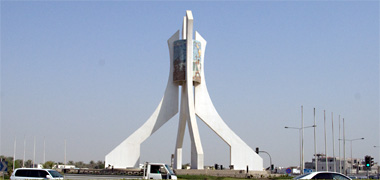
This sculpture, on the roundabout where the Rayyan and ‘D’ ring roads meet, has a familiar style to it, perhaps because the use of a fretted design seems to be a feature of many of the public sculptures in Doha. Although there is a hint of the della about it, there seems to be no design rationale I can discern. The detail at the top is illegible to drivers who, in any case, should be concentrating on the road, and the form has no link with the culture of the country.
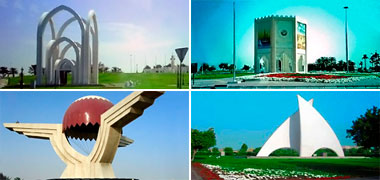

The sculptures dotted round the country are an interesting group and worthy of a study in themselves. But, as I don’t have many photos of them, it won’t be me making it. Public sculptures, in an Islamic country, are fascinating not just for the fact that they’re there at all, but for the images that are represented – both in terms of their explicit and implicit demonstration and meaning. Bearing in mind the Islamic history in two dimensional design, it is interesting to speculate on the vocabulary of these sculptures. They certainly do not seem to me to represent anything traditional in artistic terms other than that they tend to represent notionally important elements of local history – incense burners, pearls, coffee pots and the like.
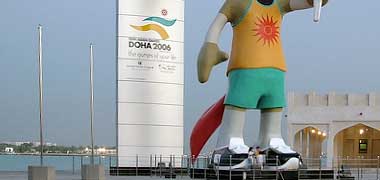

Having said I won’t be writing about sculptures, these two examples are different from the ones established by the State and, I think, worth commenting on. The first is of the mascot, ‘Orry the Oryx’, that is being used to promote the 2006 Asian Games to be held in Doha in November 2006. What is unusual – apart from the fact that the oryx is a lovely animal, look at this photo – is the size of the sculpture though it certainly holds its own against the scale of the Corniche.
The various Games’ mascots seem to operate under a law to themselves. The sculpture example above appears to be part of the Western commercialisation of the Gulf that many complain about. Sited adjacent to a replicated, traditionally detailed building, it makes an interesting contrast, reinforcing both the novel and traditional in their juxtaposition.

A number of the water tanks in Doha were treated as advertisement boards for the Games. I believe this is an excellent way to deal with objects that are often painted in colours or patterns in an attempt to reduce their visibility. Such attempts are never successful. Bold colour is a successful treatment for an object that often suffers from design neglect. The principle seems to be continuing after the Games, the designs not being allowed to fall into decorative disrepair.

Here is a photograph of ‘Orry the Oryx’, the Asian Games symbol swimming round one of the water towers. Used in this way, it is an excellent way of advertising on a three-dimensional shape, and an attractive and novel treatment for water tanks within the State. It is surprising that it has taken such a long time to see water tanks used in this obvious manner and an interesting addition to the urban scene.

The fourth of these water tanks again illustrates how well suited they are to displays running round them. Perhaps the concept of using water tanks for display and advertisement will be developed in future, in particular it would be good to see mobile lighting and projection systems transforming them into exciting displays at night. There might also be the possibility of having a mobile display running around them.

Since making the above notes at the time of the Asian Games in 2006, it appears that at least one of the water tanks in Doha has been re-painted, this time as a welcoming advertisement for visitors to Doha. As suggested above, this is a sensible way to use large objects as elements of the urban design vocabulary. The use of strong colours and contrast make them important objects in this landscape, though the messages they send are not always as successful as they might be. In the case of this water tank the lettering would be more useful at a larger size or with a stronger font, and with more contrast in tone with the ground on which it partially sits, in this case, the tree and building outline. Compare this legibility with the word ‘precision’ on the green water tank above.
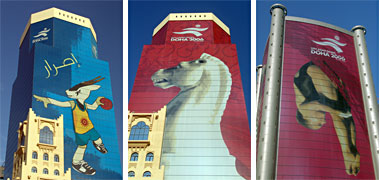
In Qatar the State has used the whole of the façades of some buildings for advertising the 2006 Asian Games. In this photo, the first two images are of the same building which has been used for two advertisements for the Games, Orry the Oryx and the second for the chess tournament. The third image illustrates the diving competition on a different building. I think the advertisements actually improve the buildings, not necessarily because of deficiencies in the buildings themselves, but in their bringing to the buildings life beyond the that of the fixed façade. I have to admit that this reflects an interest I’ve had for a long time. I would like to see far more use of the façades of buildings in terms of display. It’s easy enough at night to effect this – though few owners or designers take full advantage of this through the use of differential and modelling lighting and elemental movement – but it’s a more difficult proposition in the daytime. Using the building to display advertising or illustrative material – static or moving – is something I would like to see far more of.

These buildings have, as you can see from even those small parts of them that are visible, little or nothing to do with Islamic or the traditional architecture of the region. Hiding the buildings behind large scale advertisements is a benefit to the urban landscape not just from the negative point of view of masking the buildings, but because the advertisements are so well done. Their scale is appropriate for reading distance, they are legible, the colours strong and suited to contrast with the general colours of their surroundings, and they bring lightness in their construction to contrast with the building materials around them; they make a more dramatic contribution to the urban scene than the buildings they mask.
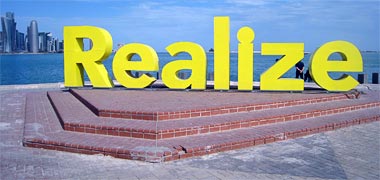
There have been a number of interesting additions to the Qatar landscape which may be difficult to class as sculptures. Here are two of them backing onto the West Bay and seen against the contrasting blue of its water and sky. Similar sculptures appear in other parts of Doha, not necessarily by the sea, and all take the form of a single word such as the first of these, ‘Realize’, but there are also ‘Think’, ‘Achieve’ and other words that appear to be designed to have an inspirational connotation. In this sense they can certainly be thought of as public sculptures, but they may also be considered to be out of place, particularly with their being, in the main, formed in the English language.

Having said that, the second photograph is of a similar sculpture, but in Arabic and is a single conceptual word that might be transliterated as ‘tatawwar’ with a meaning of something like ‘to be developed’ or ‘evolve through time’ or ‘evolve in stages’. Perhaps somebody would correct me? But the point is that they are all three-dimensional forms of two-dimensional words and are obviously designed to be read against a backdrop rather than seen as sculptural three-dimensional studies. That is the point; they are intended to be read. Their content is their message and, in this, they run the risk of appearing hectoring or patronizing.
Public sculptures are usually introduced to benefit those who move around urban spaces, heightening their enjoyment through enrichment of the harder physical elements of urban environments and, perhaps, giving pause to think or reflect. In this they are thought to have a complementary character to the softer presence of landscaping, though this latter benefits us in bringing colour, movement and smell to the environment as well as by its associated flora and fauna. It might be considered that these sculptures are beneficial, even though they are an extremely simplistic and literal translation of that intent.
Whether or not it is good to scatter the country with words or exhortations that might be thought inspirational is not a debate to make here. The point is that the majority of them are written in the English language, an issue I feel debases the local culture even though, in the second example, there is a strong calligraphic tradition in the Islamic world. Having predominantly Western architecture forming the physical setting in the urban public realm is one thing; introducing exhortations in foreign languages is very different.
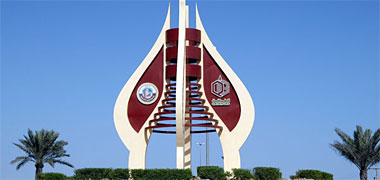
There are a number of sculptures now being commissioned by government companies. This photograph is of a Qatargas sculpture and illustrates the typical character of design in the Gulf where there is a conflict between advertisement and art. Generally I find these designs more complex than they need to be. The four stylised flames have on them both a government roundel as well as the Qatargas logo, the letters ‘QG’ being formed of vertically elongated hexagons, and I believe that these, together with the horizontal bands linking the flames, detract from the simplicity of the flame elements and what might have been a more memorable design. However, I realise this is a personal view.
From a more strategic point of view it is interesting that commercial sponsorship is deemed to require an advertisement rather than a more pure work of art commissioned by the company. Perhaps this will change with time but, for the moment, you can anticipate that sculptures will effectively be used as signs for such companies.
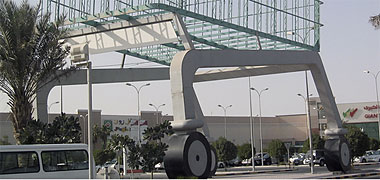

Compare this sculpture with the above in terms of concept. These two photographs show the scale of a shopping basket sculpture in one of Doha’s supermarkets. It is a curious object, bringing something of north American advertising into the Gulf. However, in its scale and subject matter it seems to be related to the character of sculptures in the Gulf. There is a naïvety about them that is endearing, but which certainly seems to fly in the face of traditional, non-representative Islamic art.
This object, though obviously associated with a commercial retail outlet, carries no advertising. It relies on the design depicted to make its point, a more subtle but lasting way of establishing its advertisement and, in this case, carried out with both elegance and wit.

Here is a sculpture – though some may not think if ot as that – which I very much like. Formed of flags it has a strong three-dimensional form combined with colour and movement which gives it a quality not seen in more static works. One of its great advantages is that, by its very nature, it can be rapidly changed to mark any special event or occasion, as it does for one here.
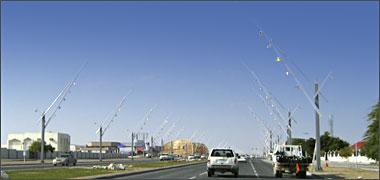
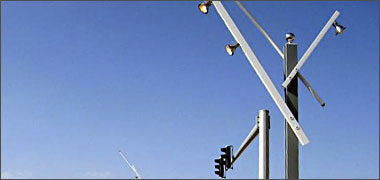

A recent addition to the urban landscape has been a new form of lighting standard. As you can see from these photos, they differ from the usual road lighting systems which are normally mounted on vertical poles. These have a strongly angled arm to which a number of lights are attached. The lowest of these three photographs shows them at their best, dramatically silhouetted against the western sky at dusk.
But I have to admit that I don’t know how effective they are likely to be at night. The lights appear to be too low to me and a potential driving hazard as the bulbs seem not to be masked well for drivers on either side of the road. In addition the angle seems to encourage light pollution adjacent to the road.
However, the reason they are illustrated here is that they lend a very strong sculptural presence to the urban scene. Perhaps this is because they have more presence due to their being angled rather than vertical, and also to their novelty. To me they have strong associations with both construction and dock cranes as well as the articulated arms of the old European and American train level crossings, but I think their main – and entirely appropriate effect – is to lend a celebratory presence to the driving experience along this road. Associated with the Games development, perhaps this is suitable.
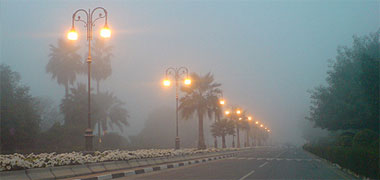
It appears there are a number of different lighting standards being used in Qatar and it would be interesting to know what the thinking is behind it. There is certainly a strong way-finding reason to use different lights as this is one of the ways in which people can readily understand where they are within the city. Here, for example, is a good example of this argument: a driver would know exactly where they are by looking at the lights. But the selection of these lights is curious. They are radically different from those above, so different in fact, that they have quite a dated look to them having a similar design to those used in some European cities where there is considered to be a need for designs thought to be in keeping with heritage architecture.

This section has looked at aspects of public art, and at first sight it might be felt that this photograph has been located in the wrong place. But for some time the Government has had a policy of displaying the results of car crashes in order to demonstrate both the results of those crashes as well as warn about, in this case, the danger of speed. Because of the manner in which the vehicles are displayed together with their scale, these arrangements can be quite as large and as dramatic as formal sculptures. But they are there for a purpose and, as such, they are also advertisements and I think fall into the categories of public art, advertisement and information displays.
Different forms of public art
The foregoing examples are some of those which have been erected in Qatar over the last few years, many of them relating specifically to the December 2006 Asian Games, for which they can be seen to be advertisements. And there is a single commercial advertisement, the shopping trolley. Those sculptures which are located on roundabouts were, I understand, part of what was seen to be a beautification programme. As such the initiative was made by the Ministry of Municipal Affairs where they were conceptualised and executed with public funding. However, the examples shown above form only a limited selection of potential public art forms.
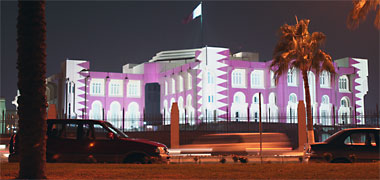
I have also used this photograph above as it illustrates a number of points, but am repeating it here for a purpose. I have placed it here as public art though in many ways it might be thought of as advertisement as well a having much to do with the pride which Qataris have in their country and a subject I’ve written a note about above, that of the use of lighting to animate buildings.
The Diwan al Amiri is the formal, if not actual, heart of government and can be thought of as the single building which represents Qatar. During the 2006 Asian Games it was illuminated at night to turn it into a representation of the Qatari flag. While incorporating this second layer of information is an understandable way of promoting the country to the many visitors in Qatar for the Games, I believe that the building has suffered as a work of public art, a function which many buildings might be said to represent. The reason for this is that the three-dimensional forms of the building have been subjugated to the two-dimensional form of the flag, even though the chevron of the flag has been made to coincide with the corner towers.
But decorating the Diwan al Amiri certainly brought change to this part of the Corniche, and I am certain that Qataris will have appreciated it, bringing with it as it did, connotations of nationalism and its concomitant pride.
There are a number of different ways in which public art can come about. But, first you should be aware that there are many countries which have introduced initiatives intended to ensure funding of public art. At its simplest, some countries require architectural projects to have a proportion of their costs expended on public art integrated within the project. In some cases, this is a form of ‘planning gain’, a term which requires developers to give something to the public realm in order to obtain approvals for their projects to be realised. ‘Planning gain’ used to be more associated with the development of public housing or communal facilities that would benefit the area in which new development was located, but the concept is now moving to encompass improvement of the physical environment, an area in which public art comes into its own.
Definition of public art
Public art, as I should have explained earlier, is art that it available for the public to enjoy within the public domain. Generally this is understood to apply to art that is located outside where it can be seen by everybody. But it can also be deployed within buildings where public have access or, in a more limited application, where it can be enjoyed by the inhabitants of, and visitors to, those buildings.
In the sense that it is understood by those dealing with its commissioning, execution and guardianship, public art relates to works of art that are specifically created and located within the public domain. In the West this often involves collaboration with, and even involvement of, the public.
Following is one way of characterising the different forms which public art might take, and which I have taken from a seminar given by an organisation devoted to working within this form of art:
- collaborations between
- artist and architect,
- artist and engineer,
- etc.,
- commissions for designated spaces, such as
- stand-alone sculpture,
- murals,
- artist-designed public spaces,
- functional artworks such as
- bridges,
- seating,
- etc.,
- land art involving
- earth modelling,
- landscaping,
- etc.,
- interactive artworks, including
- sound, and
- light,
- new approaches to
- monumental,
- memorial, and
- statuary art,
- temporary interventions, and
- community or process-led projects.
You can see from this listing that the sculptures on roundabouts relate to only one of the types listed above with, perhaps, a second relating to the painting of water towers and three-dimensional flag arrangements. This leaves a lot of opportunities for other forms of art to be encouraged.
It is also evident that public art has a much wider meaning than that which is commonly understood. It includes not only sculpture as objects within the public realm but also the use of materials that are impermanent as well as activities, performance and temporary interventions.
In a wider sense public art can be understood to include the detailing of buildings and the spaces around them. In this, the drive in the West to design buildings that induce a more sympathetic response in those using or moving past them has been one of the initiators of legislation enforcing expenditure for public art in architectural and urban design projects, the purpose being to enliven or uplift feelings of those moving in and around those projects.
It can only be good for the users of buildings and the spaces around them to have more detail to catch and hold their interest, and there is the additional benefit that there are significant works of art being produced. In many ways this trend seems to be moving towards the conditions which obtained during the Renaissance when patrons ensured that the skills of artists, architects and engineers were used to integrate and beautify those spaces within and around which people moved on business or pleasure.
But much of this can be thought to have been written from a Western perspective; consideration should be given to the manner in which Islamic traditions have created and viewed art related to buildings.
The lighting of buildings
As touched upon elsewhere, I believe that insufficient thought goes into the lighting of buildings at night; that this element of design is not considered as a necessary and integral element of the design process. There are a number of reasons for this, one of the main ones being that many designers and their clients believe it to be an additional cost and one that can be readily dispensed with. Where funds are available they tend to be found after the building has been completed and are seen, often, as part of the security arrangements for the building, or its advertisement.
But a night lighting scheme should be more than this. It represents not only a chance to model the building in a static manner, one which contrasts with the moving modelling provided by the passage of sun and daylight across a building in daylight hours, but also one which brings a degree of mobility into the building. As such it represents the opportunity to model the building in a manner or manners incapable of being replicated by day. This can bring mood, entertainment, presentation, advertisement and a number of other effects into the way the building presents itself and is experienced. Having said that, there is usually no coordination of lighting between the designers or owners of adjoining buildings even though, in some jurisdictions, planners take some trouble to address the issues relating to the design of adjacent buildings by day.
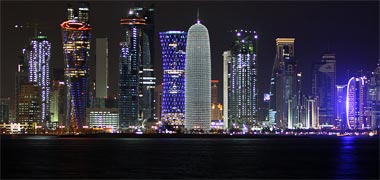

The first of these two photographs illustrates a partial view of buildings on the West Bay, as they are seen across the water, Jean Nouvel’s building standing out at the centre. What is evident here is that different levels of skill or perception have guided the designers of the different buildings. Nouvel’s tower enjoys the benefit of having a façade created of a geometric mesh and this has enabled the lighting scheme related directly to this geometrical covering to emphasise the geometry of the façade, a similar method being used on the building behind and to its left. Usually these lighting schemes are situated in a way which illuminates the façades of buildings whereas many of the other buildings rely for their lighting effect on the internal lights viewed through their windows. In the case of the Nouvel building, the lighting elements are situated behind the façade as shown in the lower photograph.
At its simplest there is the opportunity to model the building to its best advantage. In order to do this the tools available are the:
- positioning of lights,
- their colour,
- strength, and
- modulation.
This last element is important as it is seldom taken account of. There is no reason why a lighting effect may not be mobile. Think of it as being similar to a searchlight sweeping a building. Modulation can be made in the colour and strength of the lighting and, even, by mobile positioning if it is not able to produce the required effect by the former two methods.

This example illustrates a good example of static lighting. Red and blue lighting has been combined to reinforce the structure of the white building and its strong modelling. The lighting is static and, while assisting in providing security to the building establishes it through uplighting as an important element of the urban scene along Doha’s Corniche. The uplighting wash was selected to bring out the character of the architecture. As has, presumably, the next example.

This to me is an interesting example of the lighting of façades. There are a number of points I want to make. First, buildings have not been all that well lit at night. The simplest way of carrying out this lighting was to place a number of uplighters on the ground adjacent to the building and flood the façade with light. The first choice to make was at what distance from the building they should be located – this should be far enough away so as not to create a nuisance for the occupants and not close enough to show up irregularities in the finish of the façade. Next, the horizontal spacing was generally determined by the rhythm of the building’s façade. Finally, there was the colour of the light, and this usually meant an inexpensive light type such as sodium which cast a yellow wash on the building which was not always suitable. Nowadays choices are made with a little more sophistication as can be seen on the photos of the Diwan al Amiri further up the page.
The building above has its façade characterised by an apparently random geometric pattern not unlike a Penrose geometrical pattern. As a consequence there is no easily perceived rhythm to the façade and so the regular rhythm of the uplighting appears unrelated to the openings in the façade, which I think is a mistake. This is also shown up by the irregular focussing of the uplighters which need to have an extremely regular washing of the façade to complement the character of the architecture. A white light has been selected to display the white finish of the façade, though there appears to be colour used in the internal corner of the building. However, what is also curious is that the façade of the building has a double construction, there being a feature of yellow lighting behind the outer façade which now appears to conflict with or be diminished by the external lighting. I wonder if the external lighting of the building was considered at the same time as its design, and if it was intended that the stronger white and yellow lighting should be stronger at the foot of the building and not more evenly displayed.

This photograph illustrates a number of points, and was originally below in the notes relating to public art. I have moved it here as it is also a very good example of a change in lighting from the traditional washing of buildings, here used as a form of national advertisement for Games held in the country. It can be compared with the photo of the uplit, washed building above. The point is that a building can have different effects created on its façade by the use of lighting, even if it is through a static lighting system.
more to be written…
Public facilities

There is a long tradition in Islam of providing benefit to others. Indeed it is a tenet of Islam that consideration should be given to the others in the community, as well as for the benefit of the whole community, if not others outside the community. Not only is the dispersing of funds to those who are disadvantaged one of the five requirements of Islam – zakaat – but it is notable that drinking fountains – sanaabir myaa’ al-sharb, masaajid, and madaaris have all been built with private funds or from awqaf endowment. This photograph illustrates the addition of a drinking fountain beside the entrance to a masjid on Umm Wishaah street in Doha for the benefit of those entering the masjid, or those passing by.

This photograph was taken outside a local masjid on the Rayyan road and is of a pair of sanaabir myaa’ al-sharb water dispensers. They are of a simple design, usually providing three or four spouts for those passing by who might be in need of water. In practice, devices like this tended to be left running, providing not just a resource for the thirsty but an aural benefit for those about to move into the masjid to pray, establishing a calming setting for the faithful.
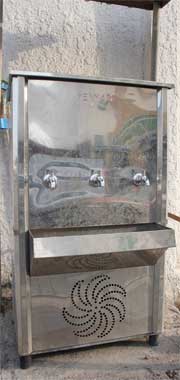
Due to the way in which these public water fountains are designed and, particularly, to the manner in which they are installed, there tends to be water spillage around them which can be unsightly and often feeds small plants which derive benefit from this source of water. But there is a benefit both in the encouraging of flora, but also creating a resource for fauna.
Water dispensers located outside masaajid combine a functional capability with a form of public art or advertisement in that they are associated with charitable purpose and mark a point in a sequence of events associated with the central activity of Islam, that of prayer. As such it might be anticipated that they would be better designed, though this may be a Western perspective.
As an aside, note that the spinning design moves anti-clockwise, and that it has seven fins, not an easy geometry to construct.
The water dispensers are certainly eye-catching in the selection of the material from which they are constructed, but poorly protected against rain and, particularly, the sun. Their design could certainly be improved upon and, preferably built into the design of masaajid and their containing walls. The first image and the two following images of units on the Rayyan Road have a form of cover which can be seen to be thoughtful, though again would benefit from a more attractive design.

There has been a degree of progress with the municipality attempting to provide a better looking enclosure. This example of a public drinking water fountain is interesting not only for its free-standing form, but in its design. There has been an obvious attempt to give it local character and, in this it is relatively successful and an interesting visual as well as practical addition to the street scene. However, the units are not always treated well, which is surprising in a Muslim society where this is an important element of faith.
Traditionally, the external faces of Muslims’ houses were intentionally unremarkable in order not to embarrass neighbours, but considerable effort went into the design and decoration of public works such as the above. Although the influence of the al-wahhabi movement in the Gulf with their strict avoidance of decoration ensured that the design of masaajid was not as ornate as were those found elsewhere in the Muslim world, where masaajid were decorated, there was signicant attention paid to combining geometry in a manner which was considered to relate the individual to his or her religion.
More to be written…
Way-finding
At its simplest, way-finding is the name given to the process by which we orient ourselves within three-dimensional space and navigate around it. More usually it relates to our location within two-dimensional space, and the ability we have to find our way within it.
I have written elsewhere about Arabs and their expertise in way-finding, this being related, in the main, to natural objects, phenomena or events. For those travelling over the desert and sea there is the need to have a constant understanding of their location. This awareness of spatial location carries with it the ability to mark progress by a person’s relationship with a variety of elements. These elements may be simple or small and, to those coming from the West, unremarkable, but for those living in these environments, they are clear markers. I have seen profiles of rocks, slight rises, the character of the ground and colours used in this manner on land, as well as the use of smell. At sea mariners will bring sight, taste and smell into play in order to navigate. Obviously the more noticeable an element is, such as a tree or hill, the more likely it will be used to find a way or to orient a person. Within conurbations, this might be thought to be a more simple exercise. Muslims have a need, five times a day, to pray towards the holy city of Mecca. Within the areas that encompass their normal daily patterns of movement, they will adopt an understanding of its location and have little need to think about its direction. However, there are increasing problems.

In urban environments way-finding is still necessary, but one that is eased by our familiarity with significant built elements of the urban scene. The example here is a simple one illustrating the importance of a small minaret, glimpsed along al-Musheirib, as a visual marker that most would easily spot and recognise. It is not a dramatic example but is exactly the type of object that helps us find our way around urban environments. Movement junctions, especially of roads, are a particularly important category of location whose marking is important to those needing to find their way around urban environments. For this reason they are often marked not only by features such as, in Qatar, a number of sculptures situated on roundabouts, but also important or tall buildings that commonly give their names to the associated junction – Arab Bank roundabout, and Jaidah tower roundabout are two such examples.
In these pages I use the expression, way-finding, in reference to the clues we use in moving around urban environments. One of the important aspects of urban design is the way in which buildings present themselves to the people moving in and around the spaces that surround them. Generally, it appears that few designers take the importance of this into consideration when designing, often seeing their buildings as being independent of situation or even of site. This is often seen in the way in which designs are presented to clients or to the public. Rarely are designs demonstrated to be considerate of a variety of views, or their importance in the urban environment shown. Sometimes they will be displayed as having a front, back and sides yet buildings are nearly always experienced in the round and, mainly, from the ground not the air. Having said that, I have written elsewhere of the need for utilities on roofs to be considered as part of the buildings’ designs and not seen as afterthoughts.
Perhaps more important, the interiors of buildings are not understood by designers as representing spaces through which people will move and, by extension, have to find their way. Architects find it relatively easy to create and manipulate space, that is one of their characteristics, but this ability will often create difficulties for the user in that way-finding is not a consideration of the designer but is often thought to be a signing exercise to be carried out later.
There are thought to be at least three factors that contribute to the lack of understanding a person may have in their location within buildings, the:
- spatial structure of the building,
- the cognitive maps that users construct as they navigate around buildings, and
- their own spatial abilities and the strategies they adopt in order to navigate.
Designers rarely take the opportunity to design buildings where they may be able to integrate a cognitive mapping system naturally within the design. In fact it can be argued that many architects deliberately produce buildings whose internal spatial complexity lends itself to navigational difficulties with users. Buildings that have repetitive floors may enable visitors to navigate relatively easily, but many buildings either do not have this type of layout, or the floors may be designed to obfuscate way-finding through a variety of decisions taken later. These may be accidental, have their root in security requirements or building regulations and might be temporary or permanent, but the needs of the user are rarely a primary consideration other than in the, usually, statutory need to sign for escape in the event of fire.
The fact is that people have varying degrees of spatial awareness, a lack of understanding of strategies for moving within and around buildings, and these factors are not understood by designers who provide no real assistance in the cognitive mapping of their buildings.
Cognitive mapping is, however, one of the areas studied by retail outlets who make it their business to lead shoppers around their stores in order to maximise or at least optimise revenue. It is also studied by security organisations who might wish to inhibit access within buildings, in addition to providing security checks and barriers to progress.
But moving back to external urban environments, it is evident that similar difficulties in way-finding are being integrated within urban designs. Many areas of cities are difficult to access unless there is foreknowledge of destinations and of the routing decisions that have to be taken in order to arrive at them. While there may be a spatial understanding of the positioning of buildings and a cognitive map of their locations, there is a disconnect between the cognitive map and way-finding that needs to be addressed better by both urban designers and the designers of individual buildings. Signing is not the best way of resolving these problems.
more to be written…
Search the Islamic design study pages
- Introduction
- Arabic / Islamic design
- Arabic / Islamic geometry 01
- Arabic / Islamic geometry 02
- Arabic / Islamic geometry 03
- Arabic / Islamic geometry 04
- Islamic architecture
- Islamic urban design 01
- Islamic urban design 02
- Islamic urban design 03
- Islamic urban design 04
- Islamic urban design 05
- Arabic / Islamic gardens
- Gulf architecture 01
- Gulf architecture 02
- Gulf architecture 03
- Gulf architecture 04
- Gulf architecture 05
- Gulf architecture 06
- Gulf architecture 07
- Gulf architecture 08
- Infrastructure development
- The building industry
- Environmental control
- Perception
- The household on its lot
- A new approach – conceptual
- A new approach – principles
- A new approach – details
- Al Salata al jadida
- Public housing
- Expatriate housing study
- Apartment housing
- Pressures for change
- The State’s administration
- Society 01
- Society 02
- Society 03
- Society 04
- Society 05
- Society 06
- History of the peninsula
- Geography
- Planning 01
- Planning 02
- Population
- Traditional boats
- Boat types
- Old Qatar 01
- Old Qatar 02
- Security
- Protection
- Design brief
- Design elements
- Building regulations
- Glossary
- Glossary addendum
- References
- References addendum
- Links to other sites